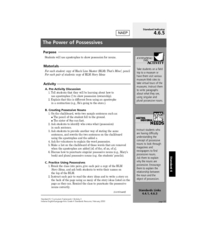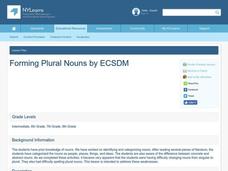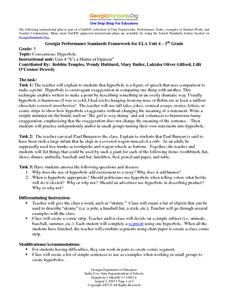Curated OER
Saving the Rainforests
Students search and study the various web sites on the rain forest. They determine parts of speech of each new word. Once this has been done, they read the composition first silently and then aloud. They demonstrate comprehension of the...
Curated OER
Three Reasons Why I Want To Be...
High schoolers investigate the process of writing an expository paper. The purpose of the paper is established in the introduction and the supporting details are sequenced in a logical order. The paper possesses punctuation and...
Curated OER
Creating a Persuasive Travel Brochure
Students create a county and develop an illustrated travel brochure to persuade elementary students to visit their county. In this persuasive writing lesson, students use descriptive language effectively in a travel brochure. ...
Curated OER
Paint My Counties: Map Coloring the Counties of Arizona
Fourth graders identify the counties of Arizona. In this social studies lesson, 4th graders color a county map of Arizona using the fewest number of colors possible. Students write a persuasive paragraph.
Curated OER
Performing With Prepositions
Fifth graders write sentences that contain prepositional phrases in them. In this writing activity, 5th graders trace prepositions in glue and glitter them in the sentences. A fun element of this activity happens after the glitter has...
Curated OER
The Power Of Possessives
The whole class with get when to use an apostrophe after this activity. They use apostrophes to show possession or ownership. This activity includes a discussion starter, a practice exercise, a story activity, and a practice...
Curated OER
Review of Adjectives
The easiest way to learn how to use adjectives is through practice, practice, practice! Print out pictures of people and various objects, and have pairs attempt to describe the items together. This plan suggests providing laminated index...
ESL Kid Stuff
Describing Things (Adjectives)
Describing things using adjectives is the focus of this instructional activity designed for language learners. Class members play games, draw pictures, and sing songs, adding adjectives to describe animals.
Curated OER
Forming Plural Nouns
Interactive SMART Board activities provide young grammarians with practice changing singular nouns to plural nouns. Learners then create collages on which they inscribe the singular and plural form of the noun label.
Curated OER
"The Drum"
Second graders read and discuss the folktale "The Drum" from India. They also answer story comprehension questions, complete an adjectives and verb worksheet, and label a map of India. Students sequence events from the story and make...
EngageNY
Grade 10 ELA Module 2: Unit 3, Lesson 2
Is good good enough? Scholars examine claims made in a speech by Elanor Roosevelt. Roosevelt claims that people should adopt the Universal Declaration of Human Rights because it is a good document. Readers discuss their ideas in pairs,...
Curated OER
Colorful Sentence Writing
Fifth graders practice expressing themselves through writing. In this language arts instructional activity, 5th graders study the parts of speech and apply to writing sentences.
Curated OER
Language Arts: Writing Diamante Poems
Third graders discover how to write diamante poems and review the parts of speech contained in them. After writing poems about their teacher, they create ones about themselves. The poems, assessed for creativity and handwriting, are then...
Curated OER
PICTURE READING - PARAGRAPH WRITING
Students investigate the elements found in a media image. The image is used to compose a descriptive paragraph. They exchange papers to discuss the writing and make changes using constructive criticism. Students also make connections...
Curated OER
Creative Story Writing
Learners recognize predictable patterns in literature. They use the selected pattern to create their own writing using the same type of literary pattern. The new writing is proofread by other students and the editing is done until the...
Curated OER
Animal Action
Students construct descriptive sentences. In this cross curricular music and descriptive writing lesson, students listen to classical music and pantomime actions that correspond to the music. Students write descriptive sentences...
Curated OER
Mouthwatering Adjectives!
Third graders write descriptions of food items in order to create a restaurant menu. They use adjectives to describe mouth-watering and vivid food and compare it to a boring adjective-lacking menu. They design and share their menus with...
Curated OER
Lesson Plan Anchored Instruction
Students explore a case study of a hearing impaired person. They evaluate obstacles the patient may face in a school setting. Students determine strategies to help the patient adapt to his hearing loss. They present their solutions to...
Curated OER
What's for Dinner? (Using Adjectives)
Sixth graders use adjectives to describe foods listed in restaurant menus. In cooperative groups, 6th graders create menus and identify the adjectives used in the menu created by their group.
Curated OER
Conventions: Hyperbole
Fifth graders discuss hyperbole. In this language arts lesson, 5th graders understand that hyperbole enables writers to make a point by describing something in an overly dramatic way. Students create a list of objects that can be used to...
Curated OER
"Journalism in Tennessee"
Students listen to headline from National Enquirer or other tabloid, listen to story "Journalism in Tennessee," compare and contrast connections between Twain's idea of journalism with present day journalism, define vocabulary, and...
Curated OER
Understanding Adjectives
Students examine adjectives. They discover how adjectives make writing more interesting. Through various activities, students describe objects using different adjectives. Students write sentences on given topics using adjectives.
Curated OER
Vivid Verbs
Students find vivid verbs in the story Thank You for the Thistle, by Doree Durston. They add vivid verbs to an existing story to make it more interesting.
Curated OER
Create a Poem
Students write three simple rhyming poems and read them aloud with rhythm. Students select two adjectives that are opposites and two rhyming verbs to create rhyming lines of the same length with an adjective-noun-verb pattern.























